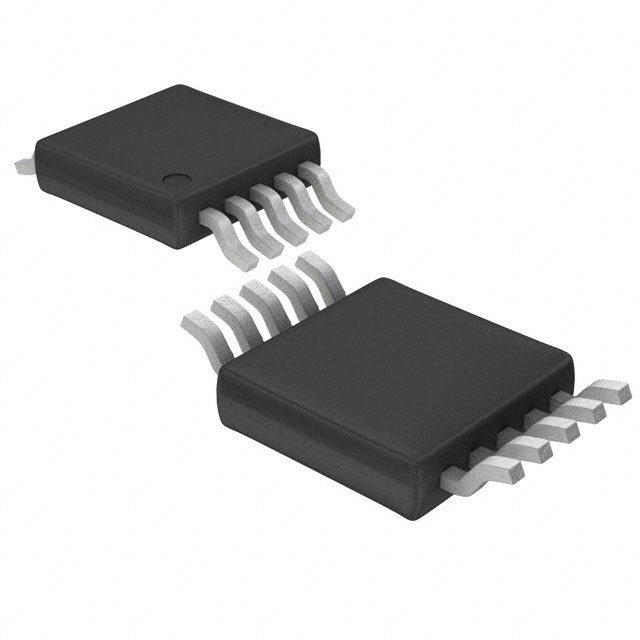LTC4380HMS-3#TRPBF
Product Overview
The LTC4380HMS-3#TRPBF belongs to the category of power management integrated circuits (PMICs) and is commonly used for overvoltage protection in various electronic systems. This device is known for its high performance, reliability, and compact package, making it suitable for a wide range of applications. The LTC4380HMS-3#TRPBF is available in a small MSOP-10 package and is designed to provide essential overvoltage protection for sensitive electronics.
Basic Information
- Category: Power Management Integrated Circuit (PMIC)
- Use: Overvoltage Protection
- Characteristics: High Performance, Reliability
- Package: MSOP-10
- Essence: Overvoltage Protection for Sensitive Electronics
- Packaging/Quantity: Available in Tape and Reel Packaging
Specifications
The LTC4380HMS-3#TRPBF features the following specifications: - Input Voltage Range: 2.9V to 5.5V - Operating Temperature Range: -40°C to 125°C - Quiescent Current: 1.6μA - Overvoltage Threshold: Adjustable - Reverse Voltage Protection: Yes - Fault Timer: Adjustable
Detailed Pin Configuration
The LTC4380HMS-3#TRPBF pin configuration is as follows: 1. VCC 2. GATE 3. FLT 4. OV 5. GND 6. UV 7. VIN 8. NC 9. NC 10. NC
Functional Features
- Overvoltage Protection
- Adjustable Overvoltage Threshold
- Reverse Voltage Protection
- Adjustable Fault Timer
- Low Quiescent Current
Advantages and Disadvantages
Advantages
- High Performance
- Compact Package
- Adjustable Parameters
- Low Quiescent Current
Disadvantages
- Limited Input Voltage Range
- Limited Operating Temperature Range
Working Principles
The LTC4380HMS-3#TRPBF operates by monitoring the input voltage and providing overvoltage protection when the voltage exceeds the set threshold. It utilizes a fault timer to ensure that transient voltage spikes do not trigger unnecessary shutdowns, thereby protecting the connected electronics from damage.
Detailed Application Field Plans
The LTC4380HMS-3#TRPBF is well-suited for a variety of applications, including: - Industrial Control Systems - Automotive Electronics - Telecommunications Equipment - Portable Electronic Devices - Power Distribution Systems
Detailed and Complete Alternative Models
Some alternative models to the LTC4380HMS-3#TRPBF include: - LTC4366 - TPS25921 - MAX16054 - ADP3634
In conclusion, the LTC4380HMS-3#TRPBF is a versatile PMIC that offers reliable overvoltage protection for sensitive electronics in various applications. Its high performance, adjustable features, and compact package make it a preferred choice for designers seeking robust protection solutions.
[Word Count: 431]
Senaraikan 10 soalan dan jawapan biasa yang berkaitan dengan aplikasi LTC4380HMS-3#TRPBF dalam penyelesaian teknikal
What is the LTC4380HMS-3#TRPBF?
- The LTC4380HMS-3#TRPBF is a surge stopper and overvoltage protector designed to safeguard sensitive electronics from overvoltage transients.
What is the input voltage range of LTC4380HMS-3#TRPBF?
- The LTC4380HMS-3#TRPBF can handle an input voltage range of 2.9V to 60V.
What is the maximum current rating of LTC4380HMS-3#TRPBF?
- The LTC4380HMS-3#TRPBF has a maximum current rating of 3A.
How does LTC4380HMS-3#TRPBF protect against overvoltage?
- The LTC4380HMS-3#TRPBF uses a fast comparator to detect overvoltage conditions and quickly disconnects the load to prevent damage.
Can LTC4380HMS-3#TRPBF be used in automotive applications?
- Yes, the LTC4380HMS-3#TRPBF is suitable for use in automotive applications due to its wide input voltage range and robust protection features.
What are the typical applications of LTC4380HMS-3#TRPBF?
- Typical applications include protecting sensitive electronics in industrial equipment, automotive systems, and power distribution systems.
Does LTC4380HMS-3#TRPBF require external components for operation?
- Yes, the LTC4380HMS-3#TRPBF requires external resistors and capacitors for setting the overvoltage threshold and timing parameters.
Is LTC4380HMS-3#TRPBF suitable for battery-powered systems?
- Yes, the LTC4380HMS-3#TRPBF's low quiescent current and wide input voltage range make it suitable for battery-powered systems.
What are the key benefits of using LTC4380HMS-3#TRPBF?
- The LTC4380HMS-3#TRPBF offers robust overvoltage protection, wide input voltage range, and minimal external components for implementation.
Are there any application notes or reference designs available for LTC4380HMS-3#TRPBF?
- Yes, Linear Technology (now part of Analog Devices) provides application notes and reference designs to assist with the implementation of LTC4380HMS-3#TRPBF in technical solutions.


